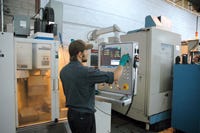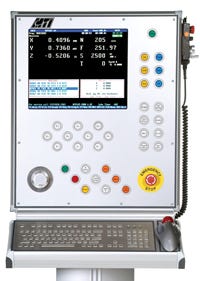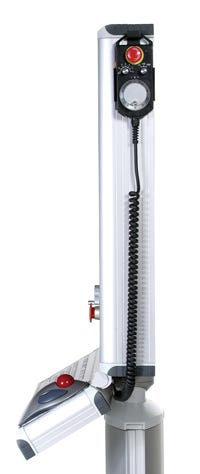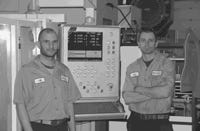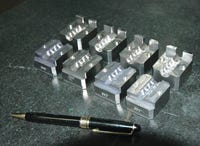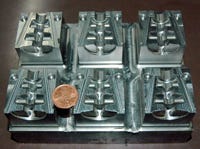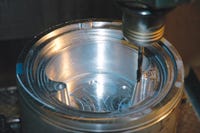A rewarding retrofit
At a moldmaking startup company in Calgary, AB, cooler heads prevailed. At a fraction of the cost of brand-new machining centers, the high-performance retrofit controls they purchased optimized the performance of their existing machines.
December 3, 2008
At a moldmaking startup company in Calgary, AB, cooler heads prevailed. At a fraction of the cost of brand-new machining centers, the high-performance retrofit controls they purchased optimized the performance of their existing machines.
A state-of-the-art constant velocity control (CVC) developed by technology entrepreneur Carlo Miceli of Miceli Technologies Inc. (MTI; Essex, ON) was retrofitted to a decade-old Fadal vertical machining center (VMC) at a startup company, Fidelity Machine & Mould Solutions (Calgary, AB). Almost immediately the co-owners of Fidelity, Jeff Litster and Ryan Arsenau, achieved the productivity and operational benefits they needed to match the rapidly growing demand for their services.
|
In just a few hours after powering it up, their old VMC reportedly was running like a new machine. And, though both Arsenau and Litster were skeptical, they soon discovered that the CVC’s learning curve took half the time involved with the other OEM controls they used.
Just last year Litster and Arsenau decided to leave Windsor, ON for Calgary, exchanging the troubles of doing business with Detroit’s automotive Big Three for the growing business opportunities sparked by Alberta’s energy boom. With two other friends from Windsor—Corey Homick and Joseph Brunelle—they opened Fidelity in the summer of 2007 and their business quickly grew, particularly in supplying tooling for cable overmolding. Today the company does three to four such jobs a week.
“We quickly became the major source for injection molds in the city, and about 50% of our work is in general and CNC machining,” Litster says.
Fidelity started out with two OKK vertical machining centers: a 1990-model MCV820 and a smaller 1996-vintage PCV55. “We needed maximum efficiency from them, primarily to keep up with cable overmolding demand,” Litster says. “Mechanically, these machines were capable of moving at 300-400 inches per minute, but their outdated controls were incapable of pushing the machines accurately at anywhere near these speeds.”
Though the principal shortcoming of the original controls was their inability to process data fast enough to push the machines to their physical limits, the controls also were unable to read in large amounts of data at high speeds, which led to data starvation—the machines literally didn’t know where to go.
“Cable overmolding is intricate and challenging work that’s always done on tight deadlines. We found we could not afford to stop production on either OKK for a control retrofit due to tight deadlines and work backlogs,” says Litster.
Such difficulties forced Fidelity to buy a third VMC, a 1998-model Fadal. However, this machine was retrofitted with MTI’s CVC control. The rest, as is said, was history.
Smooth operators
An MTI retrofit control on a well-preserved, used, midsized VMC reportedly costs about $120,000, about one-sixth of the $750,000 installed price on a comparable new machine, which would have busted Fidelity’s budget.
“We’ve got a lower-cost machine that performs better than a high-end new machine tool,” Litster says. “We saw the value in constant-velocity cutting, and the options and features were important, but MTI’s service was a major factor that helped tip the scales. So was the company’s integrity.”
In addition to the hundreds-of-inches-a-minute speeds offered by CVC machining, and the look-ahead capabilities it provides, high accuracy is what’s most important at Fidelity. “Removing material fast is not our main goal,” says Litster. “Most of our jobs are small. The cores and cavities for an overmolded cable are about the size of a paperback novel. But these small blocks actually present more of a problem than most machining, because there is so little working area inside the core and cavity. Small cutters and tight radii often present more of a challenge and more difficult geometry, and smaller cutters are far less forgiving.”
Fidelity uses ball-nosed cutters as small as 0.015 inch in diameter. It also builds tools for applications requiring critical surface finishes. “We usually feed much faster when finishing than when roughing,” Litster says. “There are still CVC benefits when roughing, but for us these are not as significant as they are in the finishing. Only about 10% of our cutting time is in roughing.”
The same functions in the CVC that provide the capability for high-speed axis travel—50,000-block/sec program execution, 80 look-ahead buffers, 4 million encoder counts, 15-digit motion control accuracy, and 0.001-µm resolution—also give Fidelity what it needs for intricate work on cable overmold components and other challenging jobs.
“Carlo [Miceli] said that this was where the CVC would really shine, and it did,” says Litster.
Cutting-edge confidence
“The MTI control also gives us unlimited processing and communication capabilities,” he adds. “We can put any size program we want in there and we don’t have to worry about overtaxing the machine, or not feeding it with data fast enough.”
“Programmed feeds are reached only under near-perfect conditions and then for only a few seconds at a time,” says MTI’s Miceli. “There are a lot of reasons for this, but what’s important is that the average machining speed is only 30-40% of what the programmer specifies. CVC controls typically attain average speeds of 80-90% of what is programmed. They’re two to three times faster.”
“Perhaps the most important thing about the MTI control is that it lets us program cutter paths with tighter tolerances,” Litster adds. “That gives us more control over the cutter and better finishes. On the other machines, we have to open up the tolerances and slow them down so much just to keep them from violating the surfaces.”
Litster lists three more performance benefits provided:
1. Cut times are down by as much as a third—some 1-hour programs now run in 40 minutes with better surface finish and longer cutter life.
2. Gains in some cutting applications are as high as 70%.
3. The ability to install CAM software on the same CPU and GUI improves efficiency, while helping operators better understand cutting tool and program limitations, enabling the company to program closer to target parameters right out of the gate.
There’s also an intangible result, according to Litster. “I notice a rise in our confidence that we can meet customer demands for quality and appearance of our finished parts. With the MTI control, we have brought something unique to the Calgary market. And we definitely plan to promote its capabilities in our marketing.”
Benefits for Fidelity
ïThe retrofittable MTI control system reportedly represents a third generation in machining technology. It’s engineered to boost the average speeds of the X-, Y-, and Z-axis drives of machine tools, even 20-year-old machine tools, and push cutters around workpieces at up to 300-500 in/min.
Gains from MTI’s CVC at Fidelity are reported to include:
• Smoother movement, resulting in less wear, better finishes, extended cutter service life, and faster cycle times.
• More processing power, which allows users to program to a higher point resolution, and tighter-tolerance bands, improving accuracy and surface finishes.
• Cost savings vs. new machines or controls.
• A quick learning curve and user-friendly operation.
• Actual machine times approaching 90% of the programmed time.
• Proving to customers that the moldmaker is dedicated to maintaining the highest level of technology.
WEB EXTRA
Impressive performance
Among the major advantages that MTI says it builds into its CVCs are:
• Eight interpolated axes.
• 50,000-block/sec program execution vs. a 2000- to 3000-block/sec execution in even the best CNCs.
• 80 high-accuracy smart buffers for look-ahead algorithms vs. the CNC norm of a few dozen lines of code—which, in effect, is just a single buffer.
• 4 million maximum servomotor encoder counts/sec, which is a measure of maximized closed-loop feedback—reportedly far more than what’s offered in even the best CNCs.
• 15-digit motion control accuracy and a minimum resolution of 0.001 µm. Few industrial systems are said to offer any accuracy and resolution below 1 µm.
Fidelity Machine & Mould Solutions | www.fidelitymachine.ca
Miceli Technologies Inc. | [email protected]
About the Author(s)
You May Also Like
